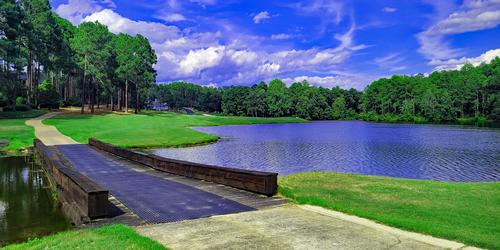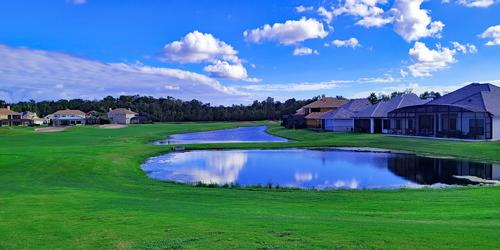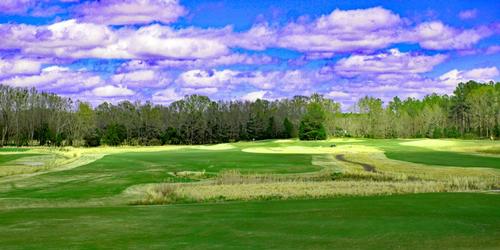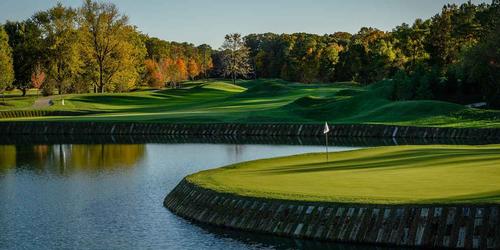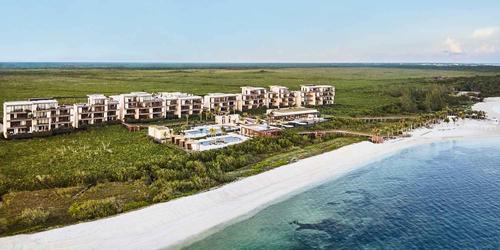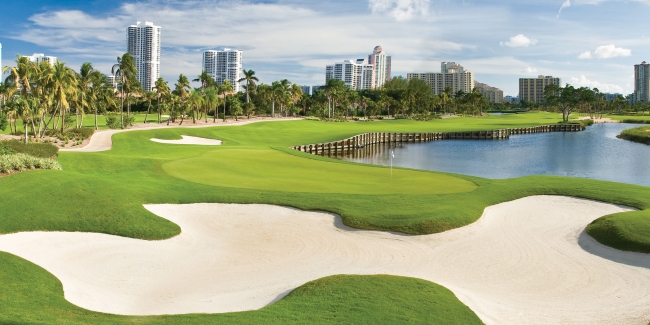
Turnberry Isle Resort - Soffer Course
Expect the Unexpected
By David Theoret
The Turnberry Isle Resort in Miami opened in the early 70's and was the brainchild of Harry Soffer and his son Don, a South Florida real estate magnate. Don Soffer and his partners transformed almost 800 acres of Florida scrub-tree swamp land near the coast into high rise condos, a hotel, a marina and the 4th busiest shopping mall in the country.
Soffer then commissioned Robert Trent Jones Sr. to design and build two golf courses, known at that time as the Aventura Country Club. Several years after selling the property, Soffer reacquired Turnberry Isle and the resort and both golf courses underwent major face lifts and PGA veteran Ray Floyd was brought in to rejuvenate both courses. He did this by trucking in untold amounts of fill which he used to create elevated fairways and greens with all sorts of flow and movement, unseen in this part of the country. Several holes were moved to the left or to the right, but the original flow of the course was maintained. Various forms of sedge and flowering vegetation were planted beneath the palms and on the high ground between playing corridors. The old RTJ courses were repetitive and unimaginative; Floyd changed that. Aventura Country Club's North and South Courses were now known as the Miller and Soffer Courses.
The Soffer Course is the longer and more challenging of the two courses; it's also the more picturesque and photographed. The course and slope ratings are higher than the Miller Course. Both the Miller and Soffer courses were originally designed by Robert Trent Jones Sr. From the back (Oakmont) tees, Soffer plays 7,047 yards, with a course rating of 74.3 and a slope of 149. Most male golfers will have all they can handle from the Blue (Pebble Beach) tees (6,537/72.3/139). Those less masochistic will move up to the White (Merion) tees (6,013/69.5/130. Women may choose to play from either the Whites or Green (Augusta) tees. A fifth set of tees (Riviera) shortens the course to 4,971. Picking the right set of tees to play from will determine how enjoyable the course is.
The Seaside Paspalum grass that is used on the tees, fairways and greens is like playing on carpet, which is both good and bad. The good is that you never have to worry about a bad lie; the ball sits up nicely. Which brings us to the bad - chipping. Unless you have an outstanding chipping game on these tight lies, you're sometimes better off putting from 20 feet or so off the green.
Memorable Holes
Number 1: Par 4, 308 yards. A short par 4, gets your round off to a great and picturesque start; but don't let the length fool you. The pond on the left can come into play on any errant shots hit that way. Trees on the right side that separate an adjacent fairway can interfere with balls hit to the right. As long as there are no oncoming players, shots can be played into the green from this adjacent fairway; just don't count it as one of your fairways in regulation. A drive down the left side of the fairway sets up an easy pitch shot to the green. You can't help but notice the waterfall as you approach the green. Pay attention to the brook that meanders down the left side of the fairway. Avoid it with your golf ball but capture it with your camera!
Number 6: Par 5, 501 yards. Longball hitters can have a go at the green in two here. Just make sure you hit it far enough to cover the lake that fronts the green. It's a very tight hole all the way down. Most players lay up before the lake, leaving an easy pitch shot to the green. Par is a good score here.
Number 13: Par 3, 192 yards. Numbers 13 and 17 are almost identical par 3 holes, with 17 playing just a little shorter. On the day of my visit, all tees were playing from the back at 192 yards - into a very stiff breeze. It was probably playing around 205 yards that day. Number 13 has very little room to bail out whereas on 17, there is room on the right side if you're not feeling up to the challenge. Both holes require a carry over water to the green. Anything on line to the green that is short is wet.
Number 18: Par 5, 514 yards. This is the hole I have been thinking about since I arrived at Turnberry Isle; I watched dozens of groups play it from my hotel room, now it is my turn! Water makes up the entire right side of this dogleg right par 5. Out of bounds looms left off the tee. Long ball hitters can definitely have a go at the island green in two depending on where they hit their drive, but I'm not sure the reward outweighs the risk. A good drive plus a good layup shot leaves an approach shot to the island green that is about the same distance as the tee shot on #17 at Sawgrass. The biggest difference here is you can't use a tee.
Last Word:
When Raymond Floyd was charged with redesigning the golf courses at Turnberry Isle, his goal was "to create a challenging and fair test to golfers of all skills and handicaps." After playing them for myself, I would say mission accomplished.
Given the fact that the land in South Florida is flat and for the most part boring, the last thing you'd expect is a layout like this. There is roll and undulation everywhere in the fairways and greens. The holes are beautifully landscaped and the fairways are manicured and trimmed beyond compare. Rumor has it that over $100,000 per hole was spent on landscaping.
When you take into account that the entire resort takes up 300 acres, which includes two golf courses - one of which plays in excess of 7,000 yards, what you have are some narrow holes - on both courses. That said, control over your tee shots goes a long way in determining whether you will score well here or not.
Seaside Paspalum is, in my mind, some of the best grass you can play on in Florida. Because the lies are so tight, your best shot from 20 yards off the green may be to putt! According to Dustin Irwin, the Director of Golf, that's what he finds himself doing several times during a round. A lot of thought has been given to the placement of hazards - both water and sand. They are strategically placed and in play regardless of which set of tees you play from.
All of the par 3 holes have water in play off the tee and require you to carry the water to reach the green. In fact water is in play on 16 of 18 holes; the two exceptions being the par 5 number 5 and the par 4, 10th hole. Although these two holes lack the wet stuff, they more than make up for it by needing to be accurate with your shots.
The one thing that has not been mentioned here are the waterfalls. You find them on several holes throughout the course, with the granddaddy of them all beside the 18th green. It's rumored to be one foot taller than the waterfall at Trump International in Palm Beach. Coincidence, or a battle of the Dons?
The last thing I'll mention are the iguanas which can often be seen sunning themselves around the tee boxes. Some of them are immense; I saw one that measured at least 5 feet from nose to tail. Definitely not my idea of a pet.
Both courses share a practice area which features a double ended driving range with many target greens, large, practice putting greens, separate chipping and pitching areas as well as bunkers resembling those that you will find on the course.
The Golf Shop offers the latest in equipment and they have all of the latest fashions from top name designers. Golf Instruction and memberships are also available.
Turnberry Isle is now part of Marriott's high end Autograph Collection. Reservations can be made by calling the resort at 866-612-7739 or visit them on line at www.turnberryislemiami.com.
Revised: 11/04/2015 - Article Viewed 29,084 Times
- View Course Profile
About: David Theoret
![]() David Theoret has been in the golf and golf travel industry for over 10 years, primarily selling online advertising. For the past seven years, he has also been a golf writer, reviewing golf courses, resorts, destinations, equipment, golf apparel, and training aids - the latter of which never seems to help. David's articles and reviews have been posted on many golf travel and equipment websites.
David Theoret has been in the golf and golf travel industry for over 10 years, primarily selling online advertising. For the past seven years, he has also been a golf writer, reviewing golf courses, resorts, destinations, equipment, golf apparel, and training aids - the latter of which never seems to help. David's articles and reviews have been posted on many golf travel and equipment websites.
Growing up in Southwestern Ontario, Canada, it was naturally assumed he would play hockey. Beginning at the age of 3 and continuing into his late 30's, he did just that. However, after one too many pucks to the head, he realized that golf was a lot easier on the body (whoever said hockey players were slow) and took the game up.
After moving to Florida and accepting a position with TravelGolf Media (now part of GolfNow) his love for the game grew exponentially. Most Saturdays you will find him on a course somewhere in Florida or on the practice range reinforcing his bad habits. David plays to a 10 handicap - unless there is money involved in which case it goes considerably higher. He currently resides in Lakeland, FL with his wife Belinda and their two "kids", Madyson and Molly.
Contact David Theoret:
GolfTrips.com - Contributor





